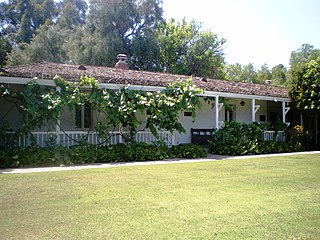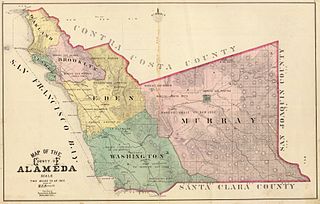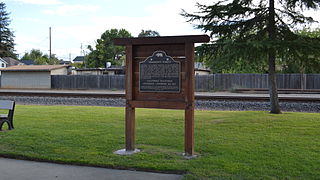Related Research Articles

Livermore is a city in Alameda County, California. With a 2020 population of 87,955, Livermore is the most populous city in the Tri-Valley, giving its name to the Livermore Valley. It is located on the eastern edge of California's San Francisco Bay Area, making it the easternmost city in the area.

The Irvine Company LLC is an American private company focused on real estate development. It is headquartered in Newport Beach, California, with a large portion of its operations centered in and around Irvine, California, a planned city of more than 300,000 people mainly designed by the Irvine Company. The company was founded by the Irvine family and is currently wholly owned by Donald Bren.

The Centinela Adobe, also known as La Casa de la Centinela, is a Spanish Colonial style adobe house built in 1834. It is operated as a house museum by the Historical Society of Centinela Valley, and it is one of the 43 surviving adobes within Los Angeles County, California. The Adobe was the seat of the 25,000-acre (100 km2) Rancho Aguaje de la Centinela, a Mexican Alta California-era land grant partitioned from the Spanish Las Californias era Rancho Sausal Redondo centered around the Centinela Springs.

Altamont Pass, formerly Livermore Pass, is a low mountain pass in the Diablo Range of Northern California between Livermore in the Livermore Valley and Tracy in the San Joaquin Valley. The name is actually applied to two distinct but nearby crossings of the range. The lower of the two, at an elevation of 741 ft (226 m), carries two railroad rights-of-way (ROWs) and Altamont Pass Road, part of the old Lincoln Highway and the original alignment of US 50 before it was bypassed in 1937. The bypass route travels over the higher summit, at 1,009 ft (308 m), and now carries Interstate 580, a major regional highway heavily congested by Central Valley suburbanization.

Murray Township was a township located in what is now the Livermore Valley portion of Alameda County, California, including the present day cities of Livermore, Dublin, and Pleasanton, and the census-designated place of Sunol.

Robert Thomas Livermore, also known as Don Roberto Livermore, was an English-born Californian ranchero. He emigrated to Alta California in 1822, eventually becoming a Mexican citizen and a prominent landowner in the Bay Area. The city of Livermore, California, and in turn the element Livermorium, are named for him.
The history of Sacramento, California, began with its founding by Samuel Brannan and John Augustus Sutter, Jr. in 1848 around an embarcadero that his father, John Sutter, Sr. constructed at the confluence of the American and Sacramento Rivers a few years prior.

The history of Chico, California, begins with the original inhabitants, the Mechoopda Maidu.

The Livermore Valley, historically known as the Valle de San José, is a valley in Alameda County, California, located in the East Bay region. The city of Livermore is located in the valley. The valley became known as "Livermore's Valley", and today as the "Livermore Valley" after Robert Livermore, an early settler and rancher in the region who received together with José Noriega a land grant composing most of modern Livermore.

The Dominguez Rancho Adobe is California Historical Landmark Number 152, and in 1976 was placed on the National Register of Historic Places by the United States Department of the Interior.
Laddville is a former settlement in the western Livermore Valley of Alameda County, California.
California Rangeland Trust is a conservation nonprofit organization founded in 1998. The Rangeland Trust claims to be the largest land trust in California, having conserved over 371,000 acres (1,500 km2) of rangeland on 90 ranches across 26 counties.

Rancho Las Positas was a 8,880-acre (35.9 km2) Mexican land grant in present-day Alameda County, California given in 1839 by governor Juan Alvarado to Robert Livermore and José Noriega. Las Positas means "little watering holes" in Spanish. The rancho included the present-day city of Livermore.
Rancho Santa Rita was a 8,894-acre (35.99 km2) Mexican land grant in the Amador Valley and western Livermore Valley, which is in present day Alameda County, California.
Rancho German was a 17,580-acre (71.1 km2) Mexican land grant in present day Sonoma County, California given in 1846 by Governor Pío Pico to Ernest Rufus. Rufus named the ranch after Hermann, the German hero who defeated the Roman legions in the Battle of the Teutoburg Forest at the time of the Emperor Augustus. Herman, in Spanish, would be written "German". The name "Rancho de Hermann" appears on the diseno, but the expediente has "German". The grant extended along the Pacific coast from the Gualala River on the north to Salt Point State Park on the south, and included present day Gualala, Sea Ranch and Stewart's Point.

Rancho Johnson was a 22,197-acre (89.83 km2) Mexican land grant in present-day Yuba County, California, given in 1844 by Governor Manuel Micheltorena to Pablo Gutiérrez. The grant was located along the north side of Bear River, and encompassed present-day Wheatland.
Rancho Honcut was a 31,080-acre (125.8 km2) Mexican land grant in present day Yuba County, California given in 1844 by Governor Manuel Micheltorena to Theodor Cordua. The rancho is named after Honcut Creek which bounded the grant on the north. The grant was bounded on the east by the Sierra Nevada Mountains, on the south by the Yuba River, on the west by the Feather River, and included present day Honcut and Ramirez.

David Jacks was a powerful Californian landowner, developer, and businessman. Born in Scotland, he emigrated to California during the 1849 Gold Rush, and soon acquired several thousand acres in and around Monterey, shaping the history of Monterey County in the first decades of American possession. He is also credited as being the first to market and popularize Monterey Jack cheese. He was born David Jack, but took to spelling his last name "Jacks" once in California.

Rancho Tularcitos was a 26,581-acre (107.57 km2) Mexican land grant in present day Monterey County, California given in 1834 by Governor José Figueroa to Rafael Gómez. Tularcitos means "place of the little Tule thickets". The grant was in the upper Carmel Valley, along Tularcitos Creek, and was bounded on the west by Rancho Los Laureles.

Hagemann Ranch Historic District is a 19th-century historic district containing a farmhouse and ranch located in Livermore, California. Within the district, the agricultural past in Livermore Valley can be remembered. It is owned and managed by the Livermore Heritage Guild, and is open to the public once a month.
References
- ↑ Degan, Ryan (November 4, 2019). "Livermore commemorates 150 years with a look back in time: City dedicates new community room to William M. Mendenhall". Pleasanton Weekly. Retrieved December 30, 2020.
- 1 2 3 4 5 6 7 8 9 10 11 12 13 14 Finn, Richard (February 2020). "William Mendenhall: The Man and What He Did for Livermore" (PDF). Livermore Heritage Guild Newsletter. Vol. 47, no. 2.
- 1 2 "Livermore History - William Mendenhall - eLivermore.com". www.elivermore.com. Retrieved March 13, 2023.
- ↑ Frank, Alan M (2019). Depot: A history of the railroad in Livermore. Livermore Heritage Guild.
- ↑ Baker, Joseph Eugene; Past and Present of Alameda County, California, Volume 1;p.441;
- ↑ Newton, Janet. "Railroad Land Grants and the Early Railroad History of the Livermore Valley" (PDF). Livermore Valley History Center.